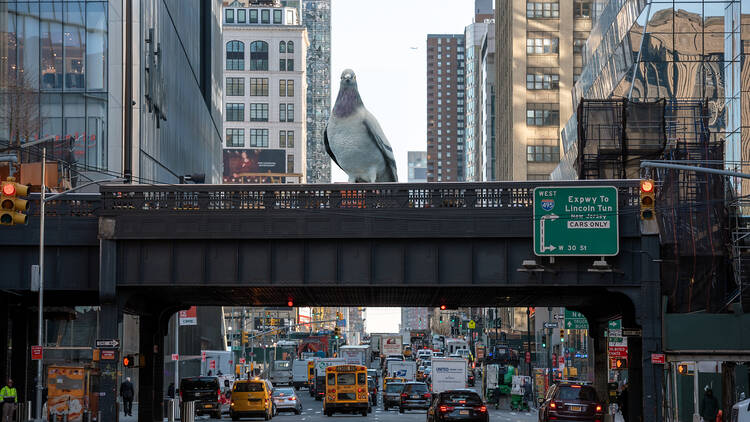High Line Art just announced its next commissions, and one is already making headlines. In October, a monumental pigeon will take up residence on New York’s High Line—specifically on the central plinth on the Spur at 10th Avenue and 30th Street. “I wanted to think about the notion of public art differing from a bronze sculpture that magically lands on a corporate plaza,” High Line Art curator Cecilia Alemani told Observer in May. “I wanted to think about pushing those borders.”
The coming work certainly does that. Titled Dinosaur, the 16-foot-high hyper-realistic sculpture of a pigeon cast in aluminum by the humorous and cynical Colombian artist Iván Argote will be the fourth High Line Plinth commission. Challenging the timeless celebratory status of monuments honoring historical figures, the work iconizes one of the most ordinary and oft-derided creatures of the urban landscape. Elevated to the grandeur of a hero or venerated personality, the meticulously hand-painted pigeon reverses the typical power dynamic between bird and human by towering over the viewer.
SEE ALSO: How Artist Andrea Carlson Heals Landscapes By Dismantling and Reassembling Them
Argote’s title draws some interesting parallels with the common ancestor of not only pigeons but all birds. Dinosaurs dominated the globe millions of years ago, then all but disappeared, and the evolution of the planet seemingly continued without them. But small feathered therapods survived and, over 66 million years, eventually evolved into the birds we know today—even pigeons. The sculpture raises questions about the survival of species and the resilience of nature.
“Like [the dinosaurs], one day we won’t be around anymore, but perhaps a remnant of humanity will live on—as pigeons do—in the dark corners and gaps of future worlds,” Iván Argote said in a statement. “I feel this sculpture could generate an uncanny feeling of attraction, seduction and fear among the inhabitants of New York.” Argote’s work on the High Line Plinth follows past commissions by Simone Leigh, Sam Durant and Pamela Rosenkranz.
The pigeon’s place in New York City
Notably, pigeons are a primary example of how some animals have adapted to a world shaped by humanity. These cliff-dwelling birds made their way to the “concrete jungle” of New York from Europe in the 1800s, when they were brought here by immigrants as both food and message carriers. Pingeons’ natural “GPS,” known as “homing,” lets them find their way back to a nesting spot without fail, and the birds played a role in communications in WWI and WWII, saving many soldiers’ lives by transporting messages quickly to the front line trenches. Perhaps pigeons are deserving of a hero’s monument after all?
Furthermore, when considering their origins, the artist notes, pigeons are a powerful metaphor for the condition of immigrants, forced to adapt to new contexts and territory, as many inhabitants of New York initially migrated here and made the city their home, like millions of other now “native” New Yorkers. It’s a theme close to the artist, who was forced to move from Colombia to France.
Iván Argote is the first artist born in the Global South and the youngest thus far to have made a work for the High Line Plinth. He’s not new to working with monuments, however. Dealing with themes like power, history, memory and social relationships, Argote’s socially engaged artistic practice has frequently intervened in public spaces, and in particular with monuments that represent historical or political figures. Altering them in subtle or bold ways and sometimes even removing and recontextualizing them, Argote challenges the traditional narratives these monuments convey while questioning the dynamics of power and propaganda they translate. His work often stirs meaningful reflection on the processes shaping collective narratives and memories and the interplay between politics, history and public spaces, forcing us to rethink and reevaluate all hegemonic narratives.
Argote is presenting two works in this year’s Venice Biennale that are also examples of this research into “anti-monumentality.” The video Paseo presented in the Arsenale depicts Madrid’s Plaza de Colón’s Columbus statue riding in exile through the capital. The relics of this monumental statue then sit in the Giardini, becoming a vessel now inhabited by nature as a powerful metaphor for a decolonization process that can bring new life. The anti-monument Descanso is a replica of the same statue of Christopher Columbus, here invaded by invasive weeds and plants (local and migrant) that devour it.

